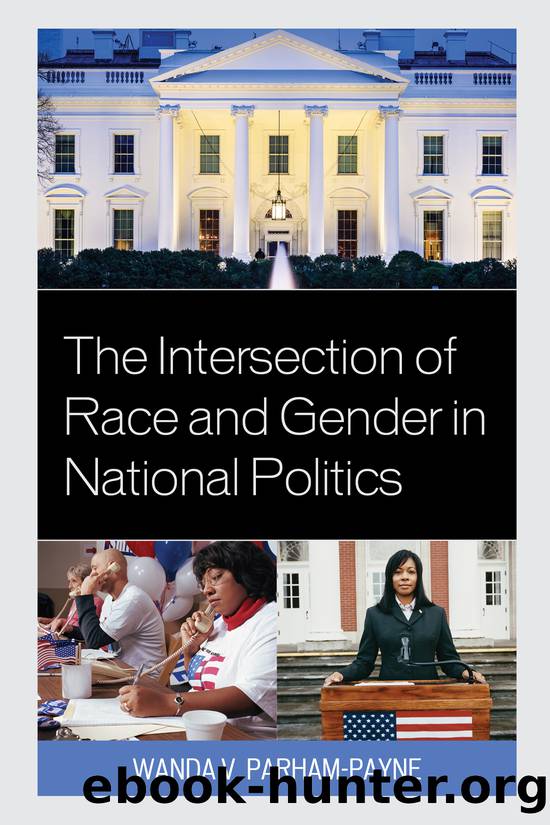The Intersection of Race and Gender in National Politics by Parham-Payne Wanda;

Author:Parham-Payne, Wanda;
Language: eng
Format: epub
Publisher: Lexington Books/Fortress Academic
Interviews with Professional Black Women
Since the establishment of slavery, African-American women have always been vulnerable to discriminatory actions within the U.S. labor market (Edghill 2007). Of note, during World War I, African-American women were often not considered first for positions in war plants. Further, despite being qualified, African-American women were denied access to lower level clerical positions that emerged upon the ending of the World War I. Because of this, they were compelled to accept positions for which they were overqualified included cleaning and doing laundry. Due to the Civil Rights Act and other employment laws, African-American women were able to enter white-collar sectors toward the end of the twentieth century (Edghill 2007). However, lower pay, in comparison to their white male and female counterparts, persisted for African-American women (Edghill 2007). In 2000, it was concluded, that toward the end of the twentieth century, white women were promoted to higher paying positions at a considerably higher rate than their African-American female counterparts (Conrad 2005).
Immediately following the first election of Barack Obama to the U.S. Presidency, informal, one-on-one discussions with professional black women of varying ages and occupations regarding President Obamaâs cabinet appointments, of which were multiple women of color, revealed anecdotal evidence suggesting that, although black women are increasingly obtaining postsecondary degrees and occupying professional positions, enduring the cumulative effects of race and gender are often the norm. Despite reports of commercial success enjoyed by women of color of late, when talking with professional black women, it was not uncommon for âwar storiesâ regarding their respective employers that point to racism and/or sexism to emerge. These stories often entailed inappropriate comments such as, âyouâre going to be our diversity monkeyâ or the well-known âyou speak so well.â Inappropriate comments mentioned also included, âyou two look just alikeâ to pairs of minority women who look nothing alike. Moreover, stories entailed the underutilization of skills (i.e., asking minority women with advanced degrees to make copies, travel arrangements, etc.). Without fail, in an exasperated tone, each conversation ended with the same comment or similar tone each timeââthey just donât know what to do with us.â
Nonetheless, one could argue that such discussions immediately following the election of the first African-American U.S. President was somewhat premature, as an adequate amount of time had not passed to truly gauge the impact of his election on the lived experiences of professional black women within the workplace. More specifically, not enough time had passed to determine the impact, if any, was perceived by professional black women upon the aforementioned cabinet posts. Therefore, subsequent to the second election of Barack Obama to the U.S. Presidency, semi-structured, one-on-one interviews were conducted with professional black women of varying ages, educational levels, disciplines, occupations, and work sectors to further probe the sentiments relayed during the above referenced conversations. Likewise, the interviews were conducted to explore professional black womenâs perceptions of the media and its portrayal of black women, and professional black women particularly. (See Table 5.1 for sample demographics.)
Overall Stereotypes
When asked to
Download
This site does not store any files on its server. We only index and link to content provided by other sites. Please contact the content providers to delete copyright contents if any and email us, we'll remove relevant links or contents immediately.
| Anthropology | Archaeology |
| Philosophy | Politics & Government |
| Social Sciences | Sociology |
| Women's Studies |
Cecilia; Or, Memoirs of an Heiress — Volume 1 by Fanny Burney(32073)
Cecilia; Or, Memoirs of an Heiress — Volume 3 by Fanny Burney(31468)
Cecilia; Or, Memoirs of an Heiress — Volume 2 by Fanny Burney(31418)
The Great Music City by Andrea Baker(30795)
We're Going to Need More Wine by Gabrielle Union(18641)
All the Missing Girls by Megan Miranda(14784)
Pimp by Iceberg Slim(13797)
Bombshells: Glamour Girls of a Lifetime by Sullivan Steve(13698)
Fifty Shades Freed by E L James(12923)
Talking to Strangers by Malcolm Gladwell(12888)
Norse Mythology by Gaiman Neil(12858)
For the Love of Europe by Rick Steves(11552)
Crazy Rich Asians by Kevin Kwan(8895)
Mindhunter: Inside the FBI's Elite Serial Crime Unit by John E. Douglas & Mark Olshaker(8718)
The Lost Art of Listening by Michael P. Nichols(7169)
Enlightenment Now: The Case for Reason, Science, Humanism, and Progress by Steven Pinker(6879)
The Four Agreements by Don Miguel Ruiz(6324)
Bad Blood by John Carreyrou(6283)
Weapons of Math Destruction by Cathy O'Neil(5843)
